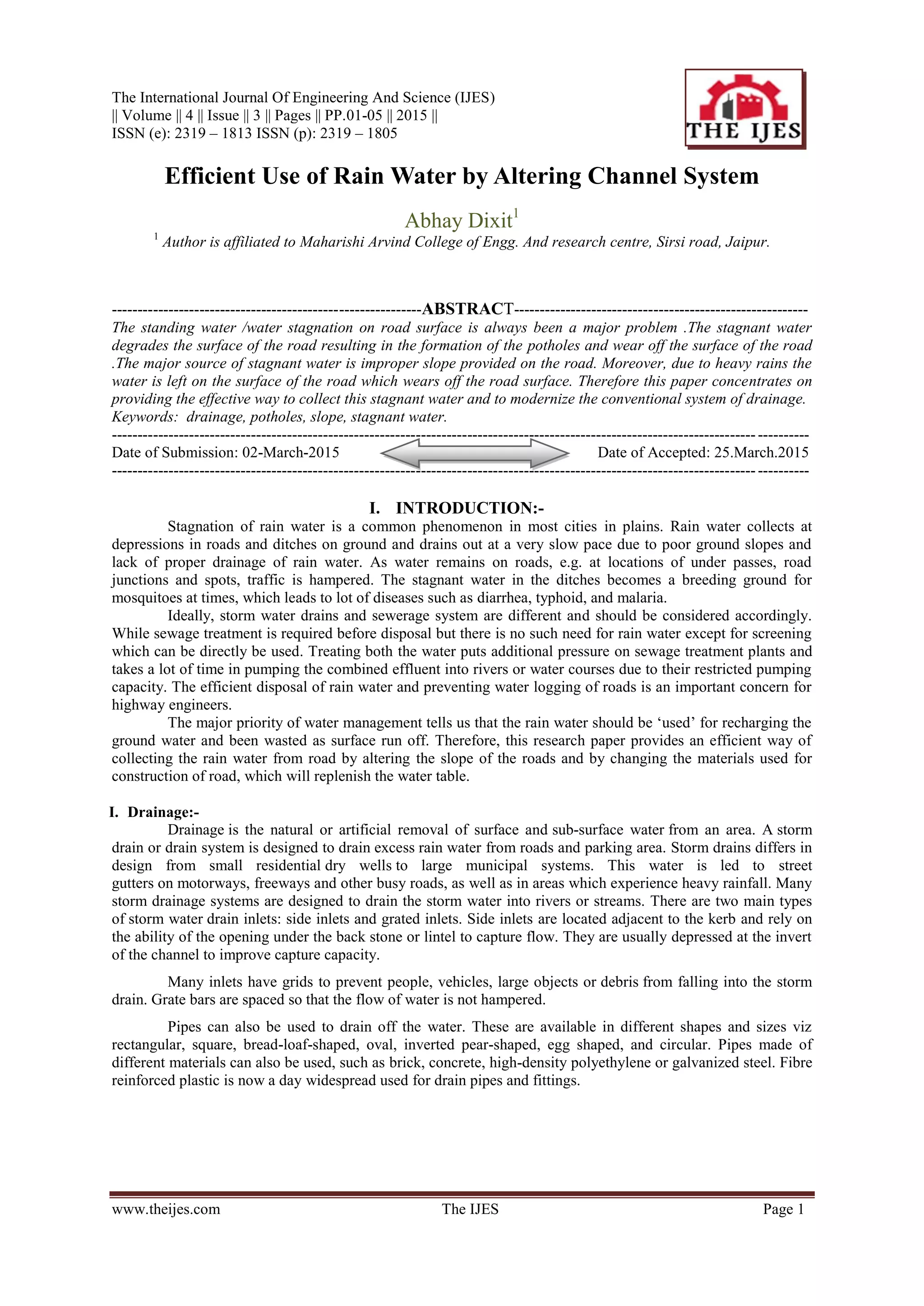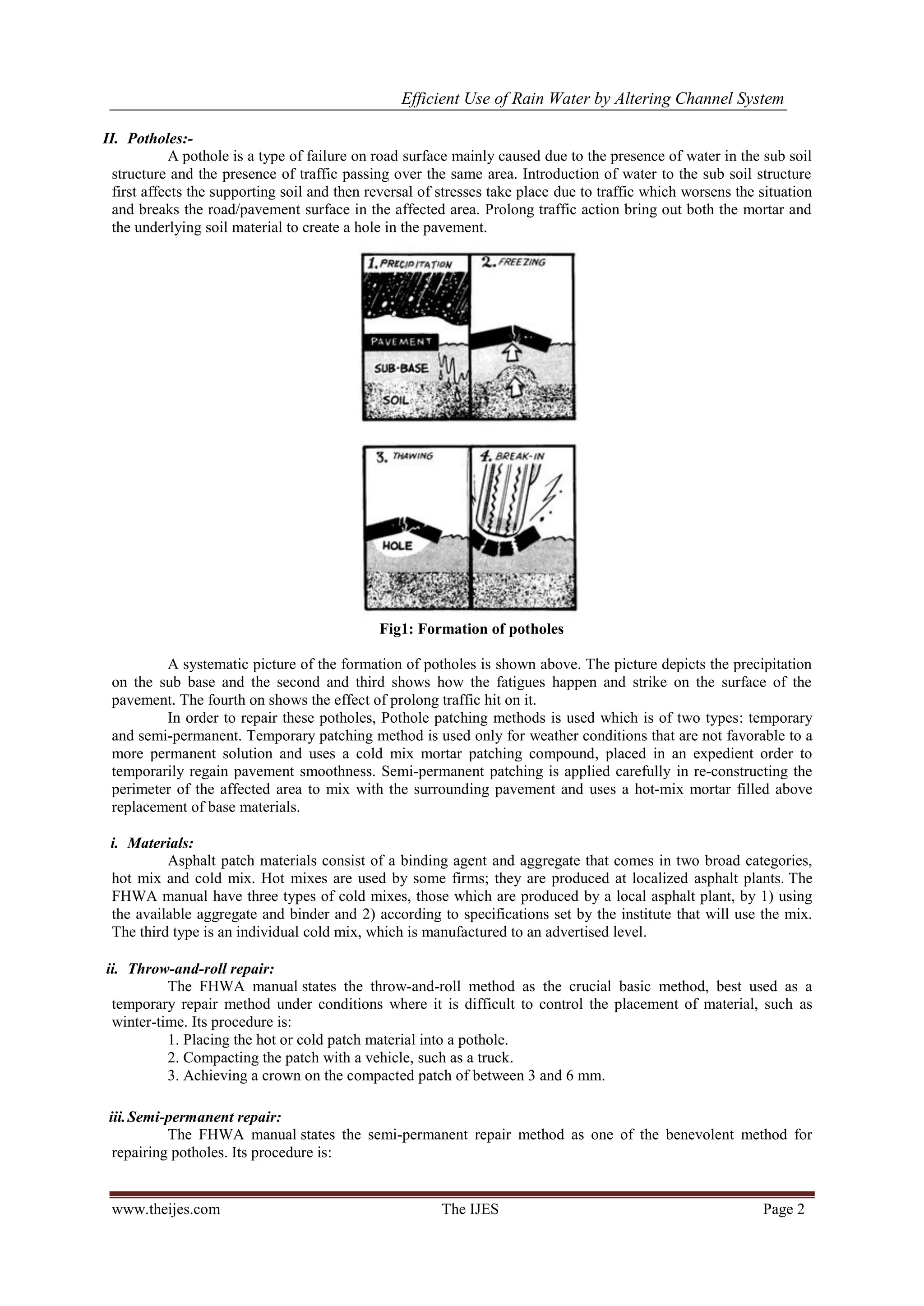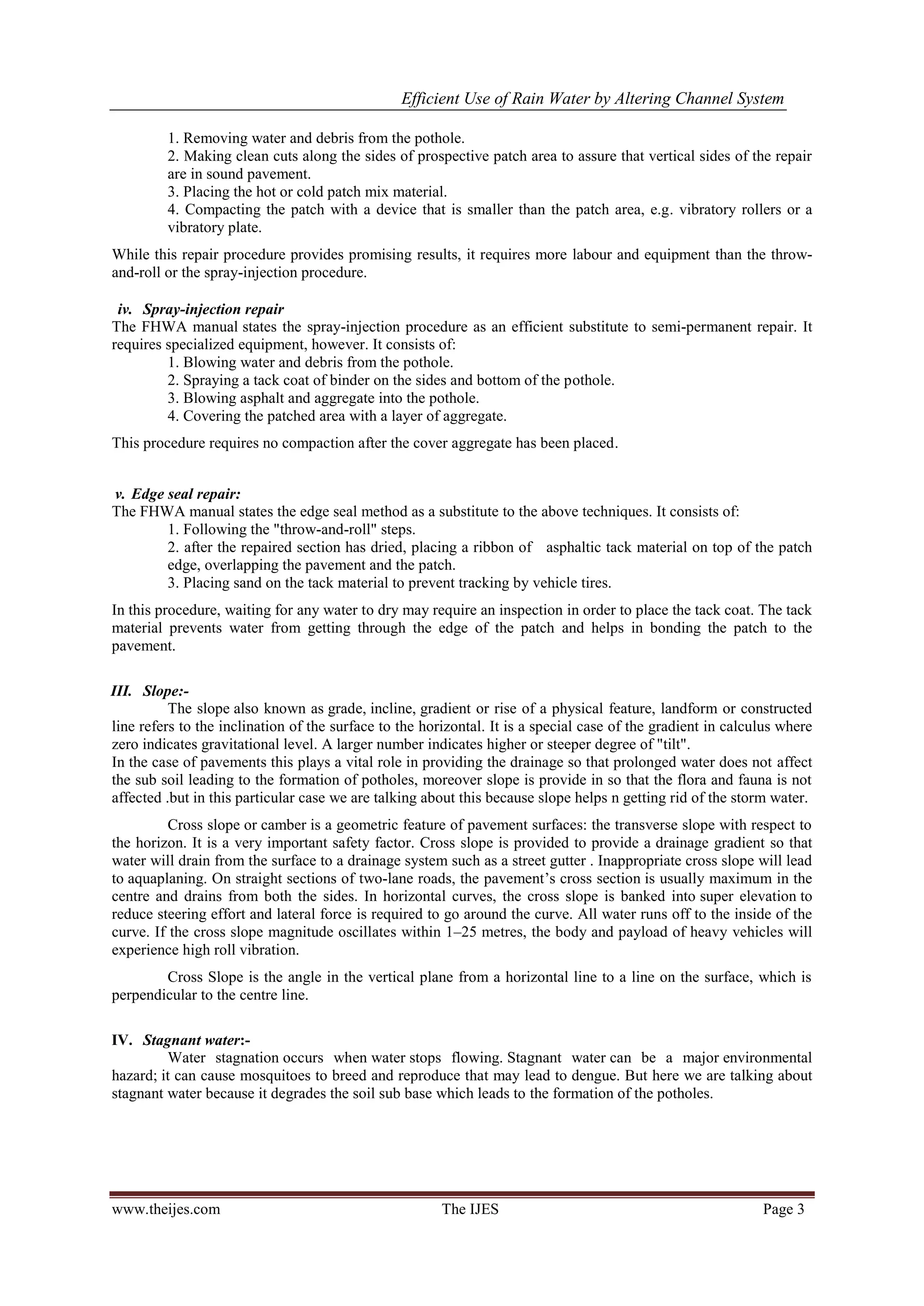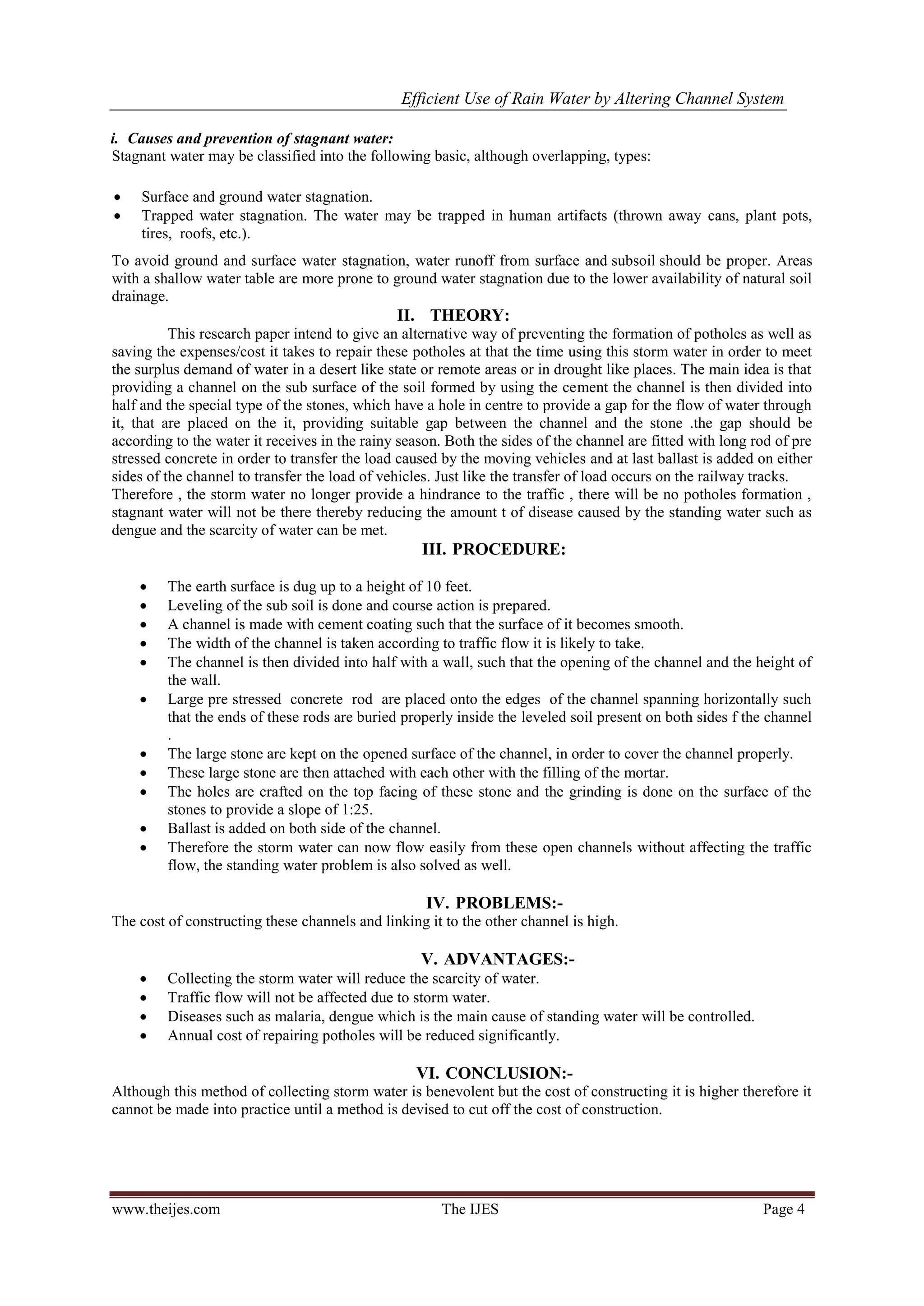This document discusses efficient use of rain water by altering road drainage systems. It describes how stagnant rain water on roads can degrade surfaces and cause potholes. The document proposes collecting stagnant water and modernizing drainage systems. It explains how altering road slopes and materials used can help drain water more effectively and recharge groundwater tables. The document also discusses drainage system types, how potholes form, methods for repairing potholes, and the importance of proper road slopes for drainage.




![Efficient Use of Rain Water by Altering Channel System
www.theijes.com The IJES Page 5
REFERNCES:
[1]. Miller, John S.; Bellinger, William Y. (June 2003). "Distress identification manual for the long-term pavement maintenance
program". FHWA-RD-0-031. Federal Highway Administration. Retrieved 2014-02-18.
[2]. Robert A.; Joubert, R.H. and Wright, E.A. (December 1989). Pothole primer—A public administrator's guide to understanding
and managing the pothole problem. Special Report. 81-21. U.S. Army Corps of Engineers—Cold Regions Research &
Engineering Laboratory. p. 34.
[3]. Wilson, T.P.; Romine, A.R. (June 1999). Materials and Procedures for Repair of Potholes in Asphalt-Surfaced Pavements—
Manual of Practice. Strategic Highway Research Program. FHWA-RD-99-168. Washington, DC: Federal Highway
Administration. p. 85.
[4]. Paige-Green, Phil. "Potholes—Repair of Potholes". Council for Scientific and Industrial Research. Retrieved 2014-02-18.
[5]. Symons, Monte (November 1999). "Pothole Repair". Tech Brief. Federal Highway Administration. Retrieved 2014-02-18.
[6]. Ashpiz, E.S., Diederich, R. and Koslowski, C. (2002). The use of spunbonded geotextile in railway track renewal on the St.
Petersburg-Moscow line. In: Proceedings, 7th International Conference on Geosynthetics; 2002; Nice, France: 14–19.
[7]. Charles, J.A. and Watts, K.S. (1980). The influence of confining pressure on the shear strength of compacted rockfill.
Geotechnique, London, U.K., 30(4): 353–367.
[8]. Esveld, C. (2001). Modern Railway Track, MRT-Productions, Netherlands.
[9]. Hicks, R.G. (1970). Factors influencing the resilient properties of granular materials. PhD thesis, University of California.
[10]. Hossain, Z., Indraratna, B., Darve, F. and Thakur, P.K. (2007). DEM analysis of angular ballast breakage under cyclic loading
Geomechanics and Geoengineering: An International Journal, Vol. 2 (3): 175–181.
[11]. Indraratna, B., Ionescu, D. and Christie, D. (1998). Shear behaviour of railway ballast based on large-scale triaxial tests,
Journal of Geotechnical and Geoenvironmental Engineering, ASCE, 124(5): 439–439.
[12]. Indraratna, B., Ionescu, D., Christie, D. and Chowdhury, R. (1997). Compression and Degradation of Railway Ballast under
One-dimensional Consolidation, Australian Geomechanics Journal, December Issue: 48–61.
[13]. Indraratna, B., Khabbaz, H., Salim, W. and Christie, D. (2003). Geotechnical characteristics of railway ballast and the role of
geosynthetics in minimising ballast degradation and track deformation. In:
[14]. RAILTECH 2003—Railway Technology in the New Millennium; 2003; Kuala Lumpur, Malaysia: 3.1–3.22.
[15]. Indraratna, B., Khabbaz, H. and Lackenby, J. (2003). Behaviour of railway ballast under dynamic loads based on large-scale
triaxial testing. Proceedings of AusRAIL Plus 2003, Sydney, 8p.
[16]. Indraratna, B, Khabbaz, H, Salim, W, Lackenby, J, Christie D. (2004). Ballast characteristics and the effects of geosynthetics
on rail track deformation. In: International Conference on Geosynthetics and Geoenvironmental Engineering, ICGGE; 2004;
Bombay, India: 3–12.
[17]. Indraratna, B., Lackenby, J. and Christie, D. (2005). Effect of confining pressure on the degradation of ballast under cyclic
loading. Geotechnique, 55(4): 325–328.
[18]. Indraratna, B. and Salim, W. (2002). Modeling of particle breakage of coarse aggregates incorporating strength and dilatancy.
Geotechnical Engineering, Proceedings of the Institution of Civil Engineers, London, 155(4): 243–252.
[19]. Indraratna, B. and Salim, W. (2005). Mechanics of ballasted rail tracks—A geotechnical perspective, A.Balkema—Taylor and
Francis, UK.
[20]. Indraratna, B, Salim W, Ionescu D, Christie D. (2001). Stress-strain and degradation behaviour of railway ballast under static
and dynamic loading, based on large-scale triaxial testing. In: Proceedings, 15th International Conference of Soil Mechanics
and Geotechnical Engineering; 2001; Istanbul: 2093–2096.
[21]. Indraratna, B., Shahin, M.A. and Salim, M.W. (2005). Use of geosynthetics for stabilizing recycled ballast in railway track
substructures. North American Geosynthetics Society (NAGS)—Geosynthetics Institute (GSI) Conference, Las Vegas,
Nevada.
[22]. Indraratna, B., Vinod J.S. and Lackenby, J. (2008). Influence of particle breakage on resilient modulus of railway ballast,
Geotechnique (in press).
[23]. Indraratna, B., Wijewardena, L.S.S. and Balasubramaniam A.S. (1993). Large-scale testing of greywacke rockfill,
Geotechnique, 43(1): 37–51.
[24]. Lackenby, J., Indraratna, B. and McDowel, G. (2007). The Role of Confining Pressure on Cyclic Triaxial Behaviour of
Ballast. Geotechnique, 57(6): 527–536.
[25]. Lemass, B.P. and Thompson, P. (2001). Decision Support for the Design of Residential Building Footing Systems. In S. Islam,
L. Borle & W. Keerthipala (Eds.), 2nd International Conference on Mechanics of Structures, Materials and Systems,
Wollongong, Australia: 193–197.
[26]. Marachi, N.D., Chan, C.K. and Seed, H.B. (1972). Evaluation of properties of rockfill materials. Journal of Soil Mech. and
Found. Division. ASCE, 96(6): 95–114.
[27]. Marsal, R.J. (1973). Embankment dam engineering—mechanical properties of rockfill, Wiley Publication, New York, 109–
200.
[28]. PLAXIS. PLAXIS 2D Version 8.2—Finite element code for soil and rock analysis. Delft, The Netherlands: A. A. Balkema
Publishers, 2004.
[29]. Raymond, G.P. (1979). Railroad Ballast Prescription: State-of-the-Art. Journal of the Geotechnical Engineering Division,
ASCE, 105 (GT2): 305–322.
[30]. Raymond, G.P. (2002). Reinforced ballast behaviour subjected to repeated load. Journal of Geotextiles and Geomembranes,
20(1): 39–61.
[31]. Rowe, P.K. and Jones, CJFP (2000). Geosynthetics: innovative materials and rational design. In: Proceedings, GEOENG
2000; Melbourne, Australia: 1124–1156.
[32]. Salim, W. (2004). Deformation and degradation aspects of ballast and constitutive modelling under cyclic loading. PhD thesis,
School of Civil, Mining and Environmental Engineering, University of Wollongong, Wollongonog.
[33]. Salim, W. and Indraratna, B. (2004). A New elasto-plastic constitutive model for granular aggregates incorporating particle
breakage. Canadian Geotechnical Journal, 41(4): 657–671.
[34]. Selig, E.T. and Waters, J.M., (1994). Track Geotechnology and Substructure Management. Thomas Telford, London.](https://image.slidesharecdn.com/a62434fa-db4f-4f38-a63d-66c6132dd212-150622040054-lva1-app6892/75/A04320105-5-2048.jpg)